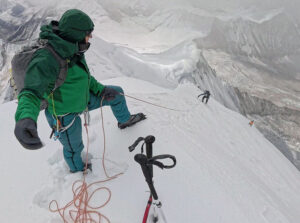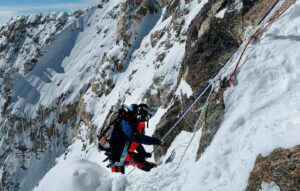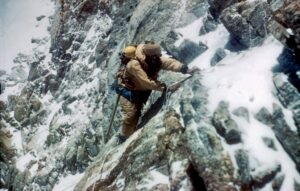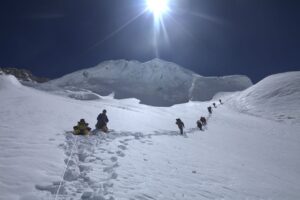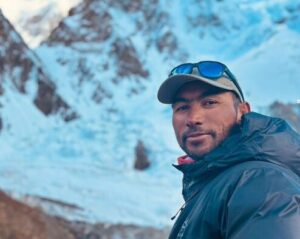As many as 50 foreign climbers are expected to attempt 8,586m Kangchenjunga this season. There are an even greater number of local staff. So the experience will be similar to the Everest of some 15 years ago.
Kangchenjunga is the third tallest of all the 8,000’ers and has 3,922m of prominence between Base Camp and summit. This long, highly demanding climb gets technically tougher as one gets higher. It requires four camps and a very long summit day from the last camp to the top and back.
One route, different styles
Besides joining fully serviced expeditions, a remarkable number of climbers will attempt Kangchenjunga without oxygen or Sherpa support. This usually means that no personal Sherpa carries their loads or accompanies them above Base Camp. However, everybody on the normal route uses ropes fixed by a previously assigned Sherpa team.

Left to right, Horia Colibasanu, Peter Hamor, and Marius Gane prepare to leave for Kangchenjunga. Photo: Horia Colibasanu
So far, only one team is looking at a different route, but there remains some confusion about what they intend. Peter Hamor of Slovakia said that he will try the traverse from Yalung Kang (8,505m) to Kangchenjunga’s main summit. However, his Romanian partners, Horia Colibasanu and Marius Gane, earlier told ExplorersWeb that they would likely climb the normal route to the main summit first. Only then will they consider traversing to Yalung Kang.
In addition to those three, Wilco van Rooijen and Cas van de Gevel from the Netherlands will also try without oxygen. This is their second attempt, after an unsuccessful try in 2018.
The two were on K2 during the 2008 tragedy, when a chunk of the great serac collapsed, stranding everyone on the summit push. Eleven died. Van Rooijen has also climbed Everest and Cho Oyu without supplementary O2, Alan Arnette reports.

Wilko van Roijen. Photo: Facebook
Marco Confortola of Italy is trying to finish his no-O2 14×8,000’ers quest. This season, he wants to climb Kangchenjunga, then Nanga Parbat. If he succeeds, only Gasherbrum I remains. Confortola attempted G1 last year but retreated in conditions he considered too dangerous.
Summit push scenarios
All climbers will share the cost of fixing the route. Weather will then dictate their pace and acclimatization strategy. This will vary with each person’s fitness, ability at altitude, and whether or not they are using bottled gas. Summit pushes should begin around the beginning of May.

The route up Kangchenjunga. Map: Namgya Sherpa
If the weather window is short and too many climbers intend to go for the top at the same time, Everest-like crowding will likely occur, especially on the technical upper sections. Jon Gupta, who is leading five clients and six Sherpa crew (all on oxygen), hopes that the groups can split their summits over two days, but that will depend on the weather.
It will be interesting to check whether the no-O2 climbers follow the fixed ropes during the summit push, or choose a variation route. Alternative routes do exist. In our Climbers’ Guide to Kangchenjunga, Nives Meroi and Romano Benet had no fixed ropes when they climbed the mountain. They just chose the most logical way up the couloirs leading to the final rocky face.
Don’t get lost
“Jorge Egocheaga [currently on his way to Lhotse’s South Face with Hong Sung-taek] had told us that there was a short rappel somewhere near the summit, and I was fearing that moment,” Nives Meroi recalled. “But we never came to a rappel point. We eventually just reached the summit. Obviously, [Egocheaga and] the Spaniards had taken a slightly different route.”

Camp 4 on Kangchenjunga. Photo: A. Zuberer/Philippe Gatta’s website
Benet also noted that commercial teams usually chose a less direct, but easier to fix route between Camp 4 and the summit.
Above C4, there are so many couloirs that mistakes are easy to make for off-route parties, especially since the summit push starts at midnight. Meroi and Benet know how easy it is to go astray: On their second attempt on the mountain, the two Italians chose the wrong couloir.
As it turns out, they were climbing with Peter Hamor and Horia Colibasanu. Hamor eventually reached the main summit, while the other three found themselves on a lower point. This is why Colibasanu has a score to settle with Kangchenjunga this year.


